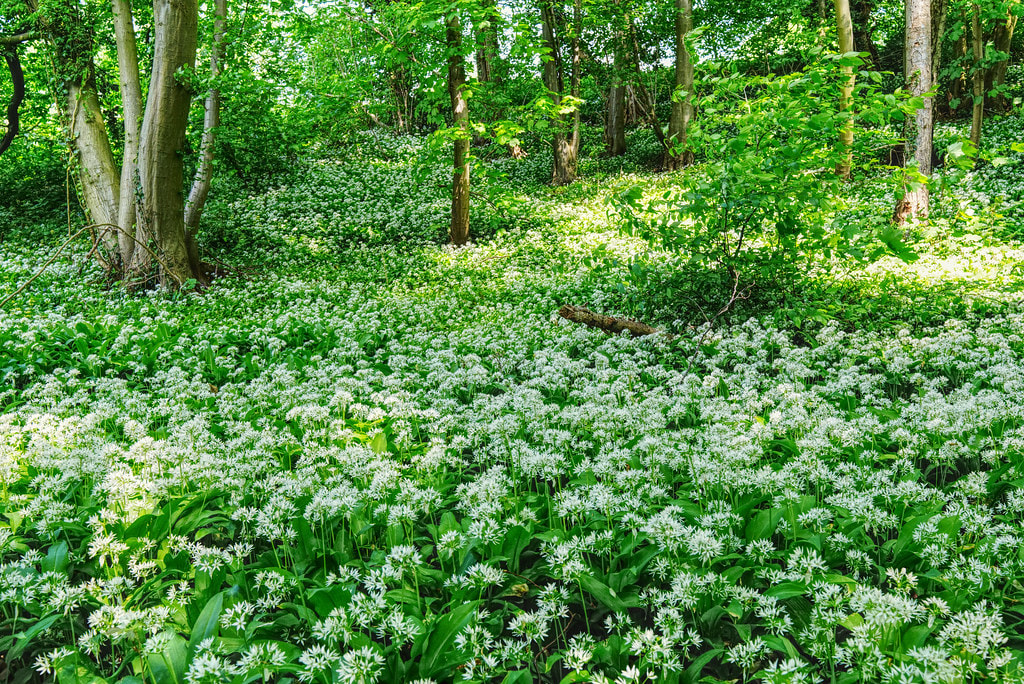Wild garlic Allium ursinumQualities of Wild Garlic Common Name:Ramsons/Wild Garlic Latin: Allium ursinum Family: Alliaceae Wildlife Value: Green veined Butterflies, long horn beetle and hoverflies amongst others. Wild Garlic or Ramsons lives underground for much of the year and then its aromatic leaves begin to grow up in March to eventually produce flowers in May. Carpets of green foliage and bunches of starry white flowers create magnificent displays in British woodlands preferring wetter and shadier parts of the wood than the bluebell which also puts on a display in May. These plants are typical shade-evaders making use of the Forest landscape before the leaves are produced to maximise the light levels. The wild garlic attracts many insects including hoverflies, beetles and butterflies. 'Nature is always lovely, invincible, glad, whatever is done and suffered by her creatures. All scars she heals, whether in rocks or water or sky or hearts.' John Muir The lore and uses of wild garlic is immense as both an ancient plant used in spells and folk traditions as well as in medical herbalism. Probably the most striking fact at the time of writing this is the faith people put in the plant in 1918 during an influenza pandemic, literally carrying a sprig of this plant for protection in their pockets. It is all too easy to put such acts in the realms of superstition when in fact the absorption of this plant can actually help cure infections. In World War Two garlic (usually cultivated) was applied to sphagnum moss and used as an antiseptic! If you have any medical conditions please check with a medical herbalist first before taking any plant and only harvest it if you are 100% sure what it is! In the realms of plants as discussed before it is also possible to connect with the qualities of a plant and ramsons is full of healing vital energy providing many nutrients with healing tendencies. In Ireland this plant has been used traditionally for tooth ache, inflamed fingers, mumps and swellings. 'nine diseases shiver before the garlic'- Irish proverb In the West of England they talk of eating leeks in March and ramsons in May so that all the year after the physicians may play! The plants properties are considered to also help purify the blood, cure boils and heal sore eyes as well as help many infections as well as sore throats and colds, the list seems endless. In the main the plant was administered by eaten it raw or boiling it in milk to produce a liquid which produced a burning sensation when applied, this made it popular as we seem to believe more in something if a reaction is induced! We now know that the most effective way to use this plant is to to crush, chew and digest the leaves as then it will release allicin that will act on micro-organisms. Wild garlic eaten by cows makes their milk undrinkable and maybe this is the origin of its name of ramsons as rams is an older word for 'rank.' The latin name of 'ursinum' comes from the latin word for bear which some may claim means it is only fit to eat by a bear or maybe it is referring to the shape of its leaves resembling the ears of a bear? However this plant is very popular as food flavouring dishes and sauces, it is best to use its leaves as the bulbs can make you feel ill and always be aware that you will kill large quantities of the plant if you trample all over it! If you would like to support our work and go even more deeply into Nature Connection please become a member and have exclusive access to our online course.
1 Comment
5/24/2020 09:23:39 pm
Garlic is nutritious and it has many uses, we should know what are the different benefits of garlic so that we may able to use it in our everyday lives. We should always have some garlic at home so that our mother can use it in our everyday lives. I want to know more about the different characteristics of this food. Let us always read the different facts so that we can maximize the use of it.
Reply
Leave a Reply. |
Details
Poetry of flowersJoin me to explore the flora of the British Isles on this blog. My intention is to attempt to capture the unique quality and beauty of each species of flower, tree or shrub. For every species featured I will be growing many more wildflowers to celebrate the joy of their existence, their intrinsic conservation value and bewildering array of uses. For nearly 30 years I have noted, studied and explored wildflowers in the field much to the patience of the walker beside me. To share this passion is a heartfelt plea to respect, preserve and care for all British Wildflowers no matter how common they seem. Archives
February 2024
Categories |


 RSS Feed
RSS Feed
